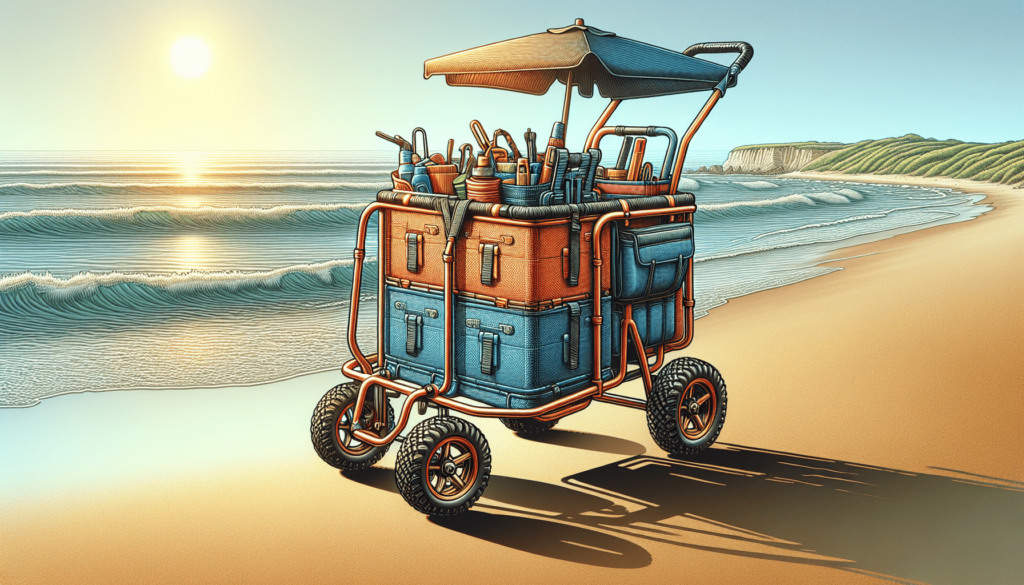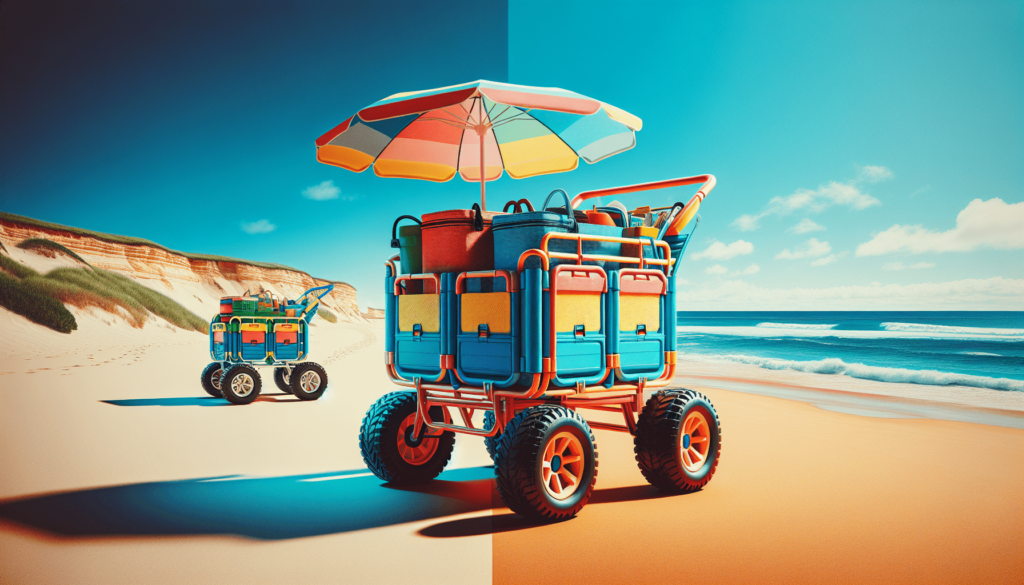Isn’t it an amazing feeling to stroll along the beach, with the sun shining, the waves gently crashing, and all your essential gear easily in tow? If you’re someone who loves a trip to the seaside, you might have realized just how crucial it is to choose the right cart for transporting your gear. Have you ever found yourself pondering whether to opt for an all-terrain beach cart or stick with a more traditional model?

Understanding Beach Carts
When it comes to a day at the beach, having the right equipment can make all the difference. Beach carts are designed to help you easily lug your essentials—whether it’s chairs, umbrellas, coolers, or beach toys—to your chosen spot on the sandy shore. However, not all beach carts are created equal.
What is a Beach Cart?
A beach cart is essentially a wheeled transportation device, varying in design and size, that you can use to transport your items to the beach. Typically made from durable materials, these carts come with different features and functionalities.
Why Use a Beach Cart?
Using a beach cart can lighten your load and improve your overall beach experience. Instead of carrying heavy items in your arms and worrying about sand getting into everything, you can simply pull your cart along. This makes for a much more enjoyable day, giving you more energy to focus on fun in the sun!
Types of Beach Carts
As with any product, you’ll find a range of beach carts available on the market. Understanding the differences between these carts can help you make an informed choice.
Regular Beach Carts
Regular beach carts are typically designed for ease of use on solid surfaces. They usually feature:
- Standard Wheels: Regular beach carts often have plastic wheels that work best on concrete or packed sand.
- Basic Frame: Most come with a simple frame to hold your items while being pulled.
- Less Weight Capacity: These carts usually have a lower weight capacity compared to all-terrain models.
While these carts can be functional, they may struggle in loose sand or uneven terrains.
All-Terrain Beach Carts
All-terrain beach carts are built to handle various surfaces, including soft sand, rocky paths, and grassy areas. Here’s what sets them apart:
- Heavy-Duty Wheels: All-terrain models often come with oversized and wider wheels designed to navigate through sand and other challenging terrains.
- Sturdy Frame: These carts are constructed with heavy-duty materials that can support more weight and withstand more rigorous conditions.
- Enhanced Features: Many all-terrain options come with features like adjustable handles, storage compartments, and even cup holders for your convenience.
All-terrain carts can make your beach day a breeze, allowing you to tackle every type of surface effortlessly.
Pros and Cons of Each Type
To fully grasp the differences between regular beach carts and all-terrain models, you might find it helpful to look at the advantages and disadvantages of each.
| Feature | Regular Beach Carts | All-Terrain Beach Carts |
|---|---|---|
| Weight Capacity | Lower | Higher |
| Wheels | Standard | Oversized |
| Terrain Capability | Solid surfaces only | Multiple terrains |
| Durability | Moderate | High |
| Price | Generally cheaper | Generally more expensive |
Regular Beach Carts: Pros and Cons
Pros
- Cost-Effective: If you’re on a tight budget, regular carts usually offer a lower price point.
- Lightweight: These carts generally weigh less, making them easier to maneuver for quick trips.
Cons
- Limited Use: Suited primarily for firm or solid ground, not ideal for soft sand.
- Less Durability: They may not hold up as well over time, especially if used on uneven terrain.
All-Terrain Beach Carts: Pros and Cons
Pros
- Versatile: Designed for various terrains, making them perfect for beach settings as well as parks and trails.
- Robust Construction: Built to last, offering better durability and weight capacities.
Cons
- Price Point: Generally more expensive, which can deter budget-minded shoppers.
- Bulky: May be heavier and more cumbersome compared to regular carts.

Ideal Use Cases for Each Type
When gearing up for your beach outing, consider when and how you’ll use your cart. Different scenarios might sway your decision.
Regular Beach Cart Scenarios
- Short Walks on Paved Paths: If your beach has walkways, a regular cart works just fine.
- Minimal Gear: When you have just a few essentials, a lighter cart may be all you need.
- Budget Constraints: If you’re looking for the most straightforward solution without breaking the bank, a regular cart will suffice.
All-Terrain Cart Scenarios
- Heavy Loads: If you’re planning to take a lot with you, like a large cooler or multiple chairs, the increased capacity and sturdiness will serve you well.
- Challenging Terrain: If you’re heading to a beach known for its soft sand, an all-terrain cart becomes essential.
- Frequent Usage: If you’re a regular beachgoer, investing in an all-terrain cart might be worth it, given its durability and versatility.
Key Features to Consider When Choosing
Regardless of which type of beach cart you prefer, certain features can enhance your overall experience. Understanding these can help make your selection process smoother.
Wheel Design
The wheel design is one of the most vital components of a beach cart. Look for:
- Size: Larger wheels tend to handle sand better, reducing the effort required to pull the cart.
- Material: Rubber wheels provide better traction compared to plastic ones, making beach outings easier.
Frame Material
The frame material contributes to both durability and weight:
- Aluminum Frames: Lightweight and resistant to rust, making them an excellent choice for beach environments.
- Steel Frames: While sturdier, they can add weight and may rust if not coated.
Capacity
Think about how much gear you usually take. Most carts list their weight capacity, allowing you to choose based on your needs.
Portability
Some carts come with foldable designs, making them easier to transport when not in use. Ensure that the model you choose fits comfortably in your vehicle.
Additional Features
Look for extra features that can add convenience to your beach experience:
- Cup Holders: Handy for keeping your drinks within easy reach.
- Storage Options: Extra compartments can help keep your items organized and secure.
- Adjustable Handles: These can make it easier for users of different heights to handle the cart without straining themselves.
Real User Experiences: What to Expect
To gain a more well-rounded view, it can be equally insightful to consider stories from those who’ve used different beach carts. Their experiences can illuminate aspects that might not be apparent at first glance.
Feedback on Regular Beach Carts
Many users appreciate regular beach carts for their simplicity. They’re often used for quick weekend getaways where only a few items are needed. Here are some common themes from user reviews:
- Easy to Use: Most find them straightforward to set up and maneuver, especially over shorter distances.
- Affordability: Users frequently mention the attractive price, especially for occasional beach visits.
However, there are downsides:
- Struggles in Sand: Several reviewers note that once loose sand comes into play, it can become a workout to pull.
- Limited Longevity: Some customers mention that even moderate use sees wear and tear, especially if not cared for.
Feedback on All-Terrain Beach Carts
Users of all-terrain models generally rave about their performance across diverse landscapes. Here’s a snapshot of common sentiments:
- Smooth Navigation: Numerous users recount how easily they can pull their cart over soft sand, grass, and rocks.
- Strong Build: Many appreciate the durability, stating it can handle larger loads without concern.
On the flip side, some challenges have been noted:
- Initial Investment: A number of users point out the higher purchase price, which might be a barrier for some.
- Cumbersome Size: Several individuals comment on how the size and weight can make it challenging to load into vehicles or transport.
The Bottom Line: Determine What Works for You
In the decision-making process, it’s essential to evaluate your specific needs, beach outing frequency, and the type of terrain you anticipate.
Personal Preference Matters
Ultimately, your personal preference plays a significant role. If you’re someone who enjoys the occasional beach trip, a regular cart can be sufficient. However, if you find yourself at the beach frequently or handling larger, heavier loads, an all-terrain model could enhance your experience.
Test Before You Buy
If possible, it’s beneficial to test out different beach cart models before making a purchase. Many outdoor retailers allow customers to demo carts, giving you a firsthand experience of their functionality.
Conclusion: Making the Best Choice
Choosing between an all-terrain beach cart and a regular model depends on your individual needs. Both types of carts have their merits, and understanding what each offers can greatly impact your beach experience.
As you consider your options, remember to factor in the type of gear you usually bring, the terrain you’ll encounter, and your budget. The right beach cart could be the game-changer you didn’t know you needed, transforming your sandy trips into effortless escapes! Enjoy your sun-soaked days ahead!

